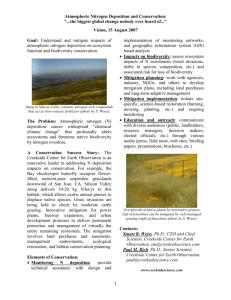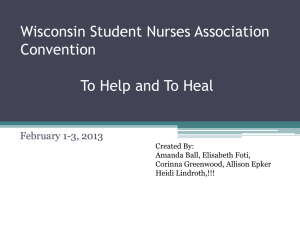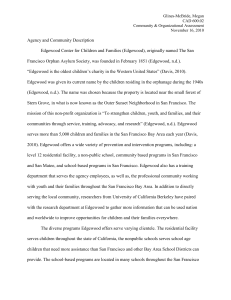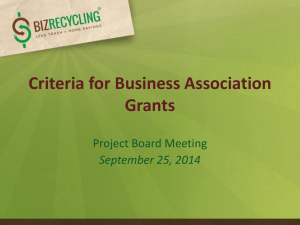Edgewood Neighborhood Liaison Committee
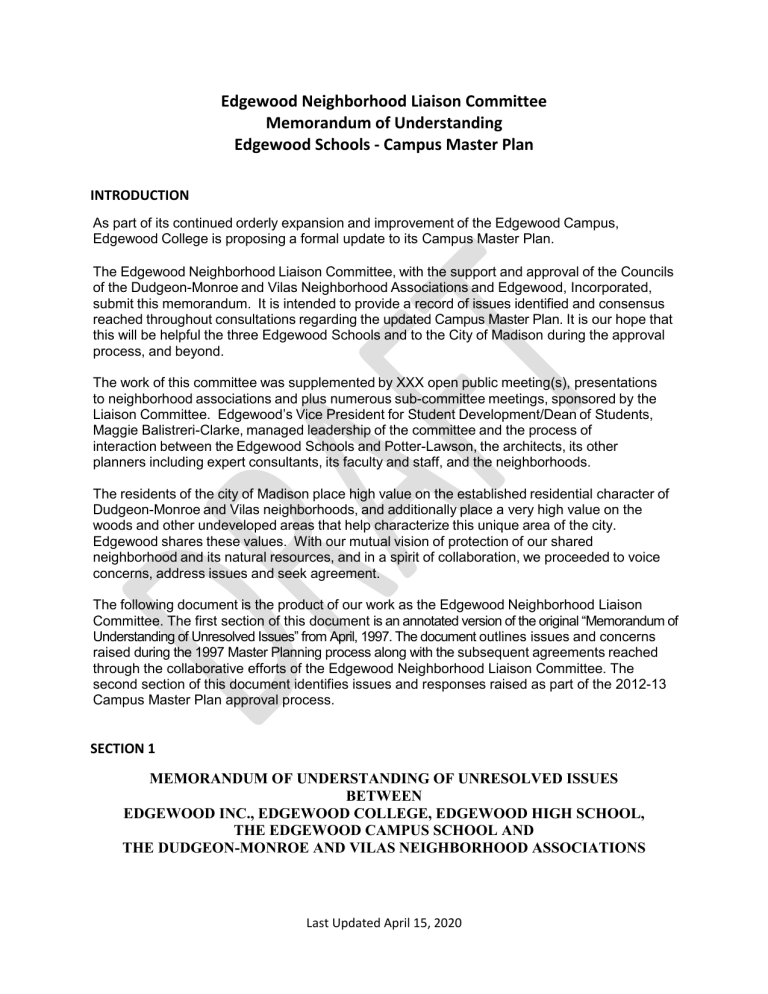
Edgewood Neighborhood Liaison Committee
Memorandum of Understanding
Edgewood Schools - Campus Master Plan
INTRODUCTION
As part of its continued orderly expansion and improvement of the Edgewood Campus,
Edgewood College is proposing a formal update to its Campus Master Plan.
The Edgewood Neighborhood Liaison Committee, with the support and approval of the Councils of the Dudgeon-Monroe and Vilas Neighborhood Associations and Edgewood, Incorporated, submit this memorandum. It is intended to provide a record of issues identified and consensus reached throughout consultations regarding the updated Campus Master Plan. It is our hope that this will be helpful the three Edgewood Schools and to the City of Madison during the approval process, and beyond.
The work of this committee was supplemented by XXX open public meeting(s), presentations to neighborhood associations and plus numerous sub-committee meetings, sponsored by the
Liaison Committee. Edgewood’s Vice President for Student Development/Dean of Students,
Maggie Balistreri-Clarke, managed leadership of the committee and the process of interaction between the Edgewood Schools and Potter-Lawson, the architects, its other planners including expert consultants, its faculty and staff, and the neighborhoods.
The residents of the city of Madison place high value on the established residential character of
Dudgeon-Monroe and Vilas neighborhoods, and additionally place a very high value on the woods and other undeveloped areas that help characterize this unique area of the city.
Edgewood shares these values. With our mutual vision of protection of our shared neighborhood and its natural resources, and in a spirit of collaboration, we proceeded to voice concerns, address issues and seek agreement.
The following document is the product of our work as the Edgewood Neighborhood Liaison
Committee. The first section of this document is an annotated version of the original “Memorandum of
Understanding of Unresolved Issues” from April, 1997. The document outlines issues and concerns raised during the 1997 Master Planning process along with the subsequent agreements reached through the collaborative efforts of the Edgewood Neighborhood Liaison Committee. The second section of this document identifies issues and responses raised as part of the 2012-13
Campus Master Plan approval process.
SECTION 1
MEMORANDUM OF UNDERSTANDING OF UNRESOLVED ISSUES
BETWEEN
EDGEWOOD INC., EDGEWOOD COLLEGE, EDGEWOOD HIGH SCHOOL,
THE EDGEWOOD CAMPUS SCHOOL AND
THE DUDGEON-MONROE AND VILAS NEIGHBORHOOD ASSOCIATIONS
Last Updated April 15, 2020
Whereas the three institutional entities comprising Edgewood Inc. (Edgewood College,
Edgewood High school and Edgewood Campus School) and the two neighborhood associations whose boundaries border the Edgewood campus (Vilas Neighborhood Association and Dudgeon-
Monroe Neighborhood Association Inc.) agreed to send representatives to convene as the
Edgewood Neighborhood Working Group during the Summer 1996, following the Madison Plan
Commission’s denial on March 18, 1996 of Edgewood’s Conditional Use Permit application, and
Whereas the goal of this Working Group was to explore whether consensus existed among the
Edgewood entities and the neighborhoods on the specific contents of a Conditional Use Permit application which could be submitted by Edgewood prior to March 18, 1997 (the prescribed waiting period after denial of a Conditional Use Permit application), and
Whereas discussions which occurred during Working Group meetings were pursued in good faith by all participants and were very detailed, and
Whereas important issues and essential understandings which were discussed are documented in
Working Group minutes, but cannot easily be retrieved, and
Whereas these issues and understandings are critical to future good relations between the
Edgewood institutions and surrounding neighborhoods,
Now therefore all persons signing this Memorandum of Understanding acknowledge familiarity with the issues and concerns detailed below and agree to fairly and openly communicate these issues and concerns to the constituencies these signing parties represent and when presenting information at public gatherings and to governmental bodies. The three Edgewood educational institutions and the two neighborhood associations whose boundaries border the Edgewood
Campus shall acknowledge at all times those issues on which consensus does not exist and shall continue to seek solutions to unresolved controversies in a forthright and open manner.
1.
Internal Campus Traffic Corridor
Meetings of the Working Group did not produce consensus on the desirability of an internal roadway which would completely connect all three Edgewood entities to the central, Monroe Street entrance. Many neighborhood residents believe that such a roadway, circling throughout the campus, is the best long-term solution to campus access and traffic circulation challenges. These challenges include the current problem of excessive automobile traffic on the Park and Pleasure Drive and the possibility that the
Campus School drop-off at the Edgedome may not result in a desired decrease in use of the Park and Pleasure Drive.
As a result of the Working Group’s discussions, the Edgewood entities have agreed to construct a roadway serving a new 38-car parking lot and drop-off/pickup circle located north of the campus school. This roadway will be built south of the Science Facility and north of the Edgedome. While Edgewood has agreed to build this roadway and relocate the Campus School parking lot, there is strong opposition to extending the roadway past the western edge of the high school gymnasium. To preserve the safety of the children
Last Updated April 15, 2020
moving between the Campus School, the High School and the new Science Facility,
Edgewood believes that a walking route free of roadway crossings is needed.
The drop off plan developed in 1996 has resulted in greatly decreased traffic on the Park and Pleasure Drive.
2.
Park and Pleasure Drive Use
The Park and Pleasure Drive is a unique treasure, having been designated specifically for
Park and Pleasure Drive purposes in a 1904 agreement between St. Clara College
(Edgewood) and the Madison Park and Pleasure Drive Association. While strongly supportive of the purposes of the 1904 easement to provide for a Park and Pleasure drive,
Edgewood reaffirms that, as the 1904 agreement also provided that the owners of the property would have several forms of access to ensure the continuing use of their adjacent land, that right remains critical to support their educational mission – the purpose of the original grant of land to the Sinsinawa Dominicans.
There exists strong opposition by many neighbors and others throughout the city to the number of motorized vehicles currently traveling on the Drive for purposes other than those intended in the original agreement. Continuing efforts will be made by individuals, elected officials and other groups to reduce traffic permissible on and attracted to the
Park and Pleasure Drive. These efforts may be in direct opposition to continuing use of the Drive as an access point to the Campus School and other Edgewood facilities. The redesign of the Campus School parking lot to the south of the school as basketball courts and a 20-car overflow parking lot with a gated entrance on the Park and Pleasure Drive is included in the initial application for a Conditional Use Permit. As stated in the approved
Master Plan, Edgewood is strongly supportive of efforts to reduce traffic volume on the
Drive and is interest in participating in discussions with the neighborhood associations and City Traffic Engineering on alternative traffic patterns on Edgewood Drive, while maintaining their right to access to their property.
The Edgewood Neighborhood Liaison Committee worked together to advocate for the closing of the Park and Pleasure Drive to through-traffic. The City of Madison developed a plan to eliminate through- traffic on the Drive. The plan was implemente d in 2006.
3.
Parking Supply and Science Facility Ramp Expansion
Meetings of the Working Group did not produce consensus on ultimate location of all of the proposed 975 parking spaces. Neighbors recognize Edgewood’s need to project where the spaces might be. However, consensus to proceed with a Phase 1 Conditional Use
Permit application shall not be construed to indicate concurrence with all proposed sites for future parking.
Meetings of the Working Group did not produce consensus on the desirability of designing and building the Science Facility parking ramp so that vertical expansion, if needed in the future, is possible. Neighborhood representatives believe vertical expansion may be needed if parking spaces proposed by Edgewood in its Master Plan are not
Last Updated April 15, 2020
authorized in future Conditional Use Permits, and if Edgewood’s projections about future parking needs are ultimately found to have underestimated actual needs. In response,
Edgewood representatives support the intent of the Master Plan to place as much of the
Science Facility parking as possible underground. Any further vertical expansion of the parking ramp would have negative visual impact on the nearby high school building and the proposed entry drive, as well as the views of the campus from Monroe Street and the
Campus School. In addition, the Science Facility would lose east facing windows and the slopes of the parking ramps would exceed recommended maximum grades. As a consequence, Edgewood concludes that an additional Phase 1 expenditure on structural capacity to support vertical expansion would not be a wise investment. All parties acknowledge that retrofitting for vertical expansion at some time in the future will be more expensive than initially building for possible vertical expansion.
Since 1996, each conditional use permit application has included an updated parking plan. A Parking and Transportation Management Plan will be included in the 2013
Master Plan.
4.
Future Fine Arts Facility
Meetings of the Working Group did not produce consensus on the building setback of the future Fine Arts Building. Many Neighborhood residents believe that a setback of 100 feet the entire Woodrow Street face of the building is needed for the proposed building.
All parties to the discussion acknowledge that with a 100 foot setback the building may accommodate fewer parking spaces, but there is not consensus on the number of parking spaces which may have to be sacrificed to obtain a 100 foot setback. Edgewood believes that a setback of 50 feet, similar to DeRicci Hall, would be appropriate along Woodrow
Street, if the future Fine Arts Facility is designed to provide a transition in building scale from institutional to residential. During the Edgewood/ Neighborhood Working Group meetings, a plan was prepared showing a minimum setback of 75 feet at the northwest corner and 95 feet at the southwest corner of the future Fine Arts facility. The 203 parking spaces proposed in the Fine Arts Facility in this plan represent approximately two thirds of the total number of spaces permitted in this location in the approved Master
Plan.
Neighborhood representatives would like to ensure that the entrance to the future Fine
Arts parking ramp is located no less than 175 feet from the Woodrow curb line.
Edgewood believes that the difference in elevation between the lower level of the parking ramp and the drive in front of DeRicci needs to be considered in determining the location of the ramp entrance. This entrance will be no closer than 120 feet from the Woodrow curb line.
Edgewood representatives state that funding for this future building is not available and that the building has not been designed. Edgewood will communicate fully and openly with neighborhood residents at all phases as design of the Fine Arts building is undertaken by Edgewood.
Last Updated April 15, 2020
The setback for the Visual and Theatre Arts Center is 70’ from the curb of Woodrow St.
This setback was determined after full discussions with neighborhood residents. In this
Master Plan update, Edgewood is depicting future setbacks of 70’ from the curbs of both
Woodrow St. and Edgewood Avenue. Setbacks for the 2013 Master Plan will be addressed in Chapter 3 of the Master Plan.
Please note that the in 1997 this space was seen as a possible site for a fine arts facility. In the 2013 Master Plan other uses will be considered such as an athletic facility.
5.
Campus Periphery
Neighborhood04/15/2020 10:05 AM04/15/2020 10:05 AM representatives have stated their intent to seek building setbacks for all future classroom buildings of 100 feet from the edge of streets adjacent to the campus and at least 200 feet from the edge of adjacent streets for all future residence halls. More than 200 feet will be requested in the case of a proposed dormitory in the southeast corner of the Edgewood property. Neighborhood representatives will request a setback of at least 50 feet from the street edge for all surface parking lots. In addition, Edgewood is requested to develop a set of architectural guidelines which it will follow as it proposes future development, including building height, angle of height increase and construction material to be used.
While Edgewood representatives believe that transitions in building height and scale from neighborhood edges are important, a minimum building setback of 100 to 200 feet is not believed to be the best approach for addressing neighborhood concerns and meeting Edgewood’s needs. A combination of moderate at-grade setbacks (e.g., 50 feet), landscaping, and a building height limitation at the setback line with an agreed angle of height increase beyond the at-grade setback is preferred.
Setbacks
A setback of 70’ is planned for any future facilities built along Woodrow Street and
Edgewood Avenue. The architectural guidelines for the 2013 master Plan will include height, massing, setbacks and materials to be used for building on the perimeter of campus.
6.
Continuing Relations Between Edgewood and Surrounding Neighborhoods
Of continuing concern to Neighborhood residents is Edgewood’s failure to clarify its intentions regarding the acquisition of property beyond the campus boundaries as those boundaries are shown in the Master Plan. In the discussions on property acquisitions outside the boundaries shown in the Master plan, the Edgewood representatives stated clearly that there are no plans at present to acquire additional property in the immediate neighborhood, but considered that Edgewood’s and neighborhood property owner’s right to buy or sell property should not be restricted. Neighborhood residents intend to pursue this issue in future discussions with Edgewood representatives.
The Edgewood entities and the Neighborhood Associations represented in the Working
Last Updated April 15, 2020
Group agree to continue to build upon the communications and understandings which have resulted from the Working Group meetings. One vehicle for communication shall be the proposed Edgewood/Neighborhood Liaison Committee. However, the task of fostering goodwill and understanding cannot be left to designated representatives. It is a task to be shared by all persons associated with Edgewood and all residents of the surrounding neighborhoods. Early, meaningful involvement of neighbors in Edgewood’s development plans and Edgewood’s involvement in ongoing programming and planning in the neighborhoods will be essential if trust and cooperation are to flourish between the
Edgewood entities and their neighbors.
The ‘Working Group’ that drafted this memo proposed that an Edgewood Neighborhood
Liaison Committee be created to serve as a coordination and communication vehicle for the 3 Edgewood Schools and the 2 Neighborhood Associations. Since its creation in
1997, this group has met regularly to discuss and address concerns. Early involvement in development plans and ongoing programming and planning as described in this document has occurred throughout the past 15 years.
The issue of property acquisition in the neighborhood remains a concern for neighbors.
In conclusion, despite the fact that consensus on all issues has not been reached during the period of time the Edgewood/Neighborhood Working Group has met, the Dudgeon-Monroe and the
Vilas Neighborhood Associations agree to support the April, 1997 Conditional Use Application provided that all aspects of the application are consistent with the understandings and agreements reached in the 1996-1997 discussions of Edgewood/Neighborhood Working Group as documented in the Conditional Use Plan Notes and Operational Agreements which are contained in the Transportation and Parking Management Plan dated April 16, 1997, provided Edgewood complies with all other conditions of approval of the Master Plan which relate to submission of the first conditional use application, and provide further discussion of issues enumerated in this
Memorandum of Understanding is not precluded.
SECTION 2
MEMORANDUM OF UNDERSTANDING – EDGEWOOD CAMPUS MASTER PLAN UPDATE - 2013
ISSUES, RESPONSES AND AGREEEMENTS
Issue: SETBACKS
Neighborhood Concerns:
The setbacks of concern to neighbors include the distance from the 80,000 sq. ft. proposed for the west side of campus, the setback from the Park and Pleasure Drive and the setback from the private residence on the northeast corner of campus.
Edgewood’s Response:
80,000 square foot building
Last Updated April 15, 2020
Setback from Kubly Property (north east corner of campus)-
Issue: COLLEGE ENROLLMENT
Edgewood’s Response: Scott Flanagan and Dean Pribbenow plan to attend the January 22
Issue: NUMBER OF RESIDENT STUDENTS
The 1997 Master Plan projected a resident population of no more than 600 students. The 2013
Master Plan projects an increase in the residential population to 800 students. As of fall 2012, there were 561 students living on the Edgewood campus. Issues of concern to neighbors include the possibilities of increased traffic, noise and disruption to the neighborhood that could come from an increase in the resident population.
Edgewood’s response:
Issue: CONSTRUCTION STAGING ALONG THE PARK AND PLEASURE DRIVE
Edgewood’s response:
Issue: PROTOCAL FOR APPROVAL OF FUTURE BUILDING PROJECTS
TO BE INCLUDED IN THE CAMPUS MASTER PLAN DOCUMENTS:
Enrollment projections for all 3 schools
Parking and traffic management plan for all 3 schools
Campus storm water management plan
Open spaces plan
Section on possible phasing of buildings
Architectural guidelines
Section on the Park and Pleasure Drive
Process for Edgewood interaction with neighbors regarding future development or implantation.
Last Updated April 15, 2020
